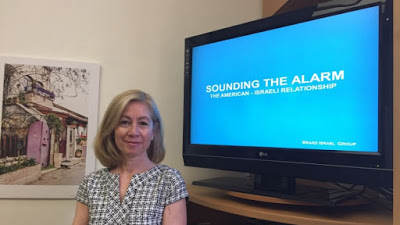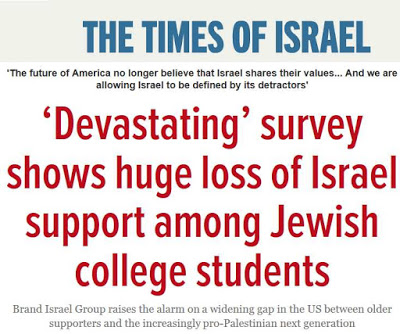It’s an ill wind that blows no good.
Despite the adoption of the new fake definition of anti-Semitism and the
attempt to depict anti-Zionism as anti-Semitic, the truth has a way of getting
through. The American Jewish community
is the most valuable to Israel, since it does its diplomatic bidding as well as
helping to fund the pariah state.
Despite the adoption of the new fake definition of anti-Semitism and the
attempt to depict anti-Zionism as anti-Semitic, the truth has a way of getting
through. The American Jewish community
is the most valuable to Israel, since it does its diplomatic bidding as well as
helping to fund the pariah state.
What a surprise it must therefore be to Israel’s veteran propagandists,
the Hasbarists who cry ‘anti-Semitism’ at the drop of a hat, that young
American Jews no longer feel an affinity with Zionism and Israel’s racial
nationalism. Settling other people’s
land, seeing the vast disparity between poor Palestinian peasants and the rich
and lush settlements isn’t a winner amongst progressive young
Jews. The far-Right messianism that believes in a
racially pure Israel and building a 3rd temple as the way to
encourage the return of the Messiah doesn’t hold too much attraction to secular
Jewish kids.
racially pure Israel and building a 3rd temple as the way to
encourage the return of the Messiah doesn’t hold too much attraction to secular
Jewish kids.
The alliance with the anti-Semitic Christian fundamentalists like Pastor
John Hagee of Christian United for Israel isn’t a vote winner either.
John Hagee of Christian United for Israel isn’t a vote winner either.
It seems to have finally dawned on Brand Israel that being high tech
savvy when you treat Palestinians as the untermenschen
isn’t necessarily a winner. The author Amanda Borschel-Dan observes that just because the
Angel of Death in Auschwitz, Dr Joseph Mengele, was a brilliant scientist,
doesn’t mean that the Nazis were attractive.
I suspect that if I had made this analogy the cacophony of Zionist propagandists.
savvy when you treat Palestinians as the untermenschen
isn’t necessarily a winner. The author Amanda Borschel-Dan observes that just because the
Angel of Death in Auschwitz, Dr Joseph Mengele, was a brilliant scientist,
doesn’t mean that the Nazis were attractive.
I suspect that if I had made this analogy the cacophony of Zionist propagandists.
Amanda of Brand Israel says that ‘Instead of stating dry facts, professionals must highlight Israel’s decency, morality and the diversity of the Israeli society in general’. This is an act of self-deception. Israel is a society where a plurality of Jews support the physical expulsion of Israel’s Palestinians and where ‘Death to the Arabs’ is the favourite chant of the Right.
Of course Amanda is desperate to find
something good about Israel and therefore settles for the aid given to Syrian
fighters as an example of Israeli selflessness.
The problem is that these Syrians are Jihadist murderers of Ahrar al
Sham and al-Nusra. What is more
pertinent is that Israel has refused to take a single Syrian refugee because
non-Jewish refugees are a threat to Israel’s racial purity.
something good about Israel and therefore settles for the aid given to Syrian
fighters as an example of Israeli selflessness.
The problem is that these Syrians are Jihadist murderers of Ahrar al
Sham and al-Nusra. What is more
pertinent is that Israel has refused to take a single Syrian refugee because
non-Jewish refugees are a threat to Israel’s racial purity.
What this demonstrates is that despite
the millions of dollars invested in pro-Israel propaganda, you cannot beautify
an ugly duckling or a detestable regime.
the millions of dollars invested in pro-Israel propaganda, you cannot beautify
an ugly duckling or a detestable regime.
Tony Greenstein
Brand Israel
Group raises the alarm on a widening gap in the US between older supporters and
the increasingly pro-Palestinian next generation
Group raises the alarm on a widening gap in the US between older supporters and
the increasingly pro-Palestinian next generation
More than a decade ago, a diverse focus group of Americans was asked to
describe a typical Italian house. Words like “lush, food, cooking, maternal, welcoming” quickly rolled of the
tongue. The same group was asked about an Israeli home and a very different
vibe was described: “concrete, strict,
ultra-religious, middle-aged ultra-Orthodox men.”
describe a typical Italian house. Words like “lush, food, cooking, maternal, welcoming” quickly rolled of the
tongue. The same group was asked about an Israeli home and a very different
vibe was described: “concrete, strict,
ultra-religious, middle-aged ultra-Orthodox men.”
This 2005 focus group was commissioned to explore the underlying image
of Israel in the American psyche. The unanimous perception was a
conflict-driven country filled with religious fundamentalists.
of Israel in the American psyche. The unanimous perception was a
conflict-driven country filled with religious fundamentalists.
Not exactly a country they were keen on visiting — or supporting.
The loose consortium of volunteer marketing and advertising executives
who commissioned the study now falls under the Brand Israel Group (BIG) rubric.
While each member of this heterogeneous Mad Men coalition had his or her own
reasons for wishing to change Americans’ innate view of Israel, for Fern
Oppenheim, co-founder of Brand Israel Group, her tipping point came after the
September 11, 2001, World Trade Center attacks.
who commissioned the study now falls under the Brand Israel Group (BIG) rubric.
While each member of this heterogeneous Mad Men coalition had his or her own
reasons for wishing to change Americans’ innate view of Israel, for Fern
Oppenheim, co-founder of Brand Israel Group, her tipping point came after the
September 11, 2001, World Trade Center attacks.
The child of Holocaust survivors, Oppenheim said she awoke from her
sense of Jewish security that day. “I
never thought I’d smell smoke living in New York,” she said in Jerusalem
this week.
sense of Jewish security that day. “I
never thought I’d smell smoke living in New York,” she said in Jerusalem
this week.
 |
|
In this September 11, 2001, file photo, thick smoke billows into the sky from the area behind the Statue of Liberty, lower left, where the World Trade Center towers stood. (AP Photo/Daniel Hulshizer)
|
Her safety bubble popped, Oppenheim decided to throw her support — and
skills — behind Israel. With her extensive marketing and management background
at such companies as Kraft/General Foods, Oppenheim began to use her
professional prowess to help the Jewish state, which she calls “the canary in
the coal mine.”
skills — behind Israel. With her extensive marketing and management background
at such companies as Kraft/General Foods, Oppenheim began to use her
professional prowess to help the Jewish state, which she calls “the canary in
the coal mine.”
The team had a revolutionary approach: Instead of the Jewish community’s
typical “shooting from the hip,” said Oppenheim, the high-level marketing execs
“rolled up their sleeves to get a
research-based understanding” of mainstream Americans’ perceptions of Israel,
and only then to create a strategy based on their research.
typical “shooting from the hip,” said Oppenheim, the high-level marketing execs
“rolled up their sleeves to get a
research-based understanding” of mainstream Americans’ perceptions of Israel,
and only then to create a strategy based on their research.
Since its initial coalescence in 2002, Brand Israel has commissioned a
large-scale segmentation study in 2010 and a followup in 2016. For anyone with
the slightest Zionist impulse, the downward slope of Israel support is
disturbing.
large-scale segmentation study in 2010 and a followup in 2016. For anyone with
the slightest Zionist impulse, the downward slope of Israel support is
disturbing.
While in Israel to present the recent 2016 BIG segmentation study, “Sounding the Alarm: The American-Israeli
Relationship,” Oppenheim repeatedly used the word “devastating” — each time without hyperbole.
Relationship,” Oppenheim repeatedly used the word “devastating” — each time without hyperbole.
 |
|
At UOIT outside Toronto, Students for Justice in Palestine activists staff their information table, 2016 (UOIT’s SJP chapter Facebook page)
|
In sum, the gap between Israel-supporters and detractors is widening.
The current Israel advocacy programs are not working, and Jewish college
students are the leading defectors from Israel support.
The current Israel advocacy programs are not working, and Jewish college
students are the leading defectors from Israel support.
‘The future
of America no longer believe that Israel shares their values’
of America no longer believe that Israel shares their values’
Mainstream Americans are not starting from a neutral perspective on
Israel; rather, they begin with misperceptions and negative assumptions. This
creates “fertile ground” for delegitimization, said Oppenheim, who also spoke
this week at the prestigious annual Herzliya Conference.
Israel; rather, they begin with misperceptions and negative assumptions. This
creates “fertile ground” for delegitimization, said Oppenheim, who also spoke
this week at the prestigious annual Herzliya Conference.
The 2016 segmentation study’s data shows that the current campaign of
depicting the Israel beyond the conflict — specifically, highlighting high-tech
achievements — is not effective. In fact, the more the study participants knew
about Israel, the less favorably they felt about the country.
depicting the Israel beyond the conflict — specifically, highlighting high-tech
achievements — is not effective. In fact, the more the study participants knew
about Israel, the less favorably they felt about the country.
According to the report’s executive summary, since 2010, claimed knowledge
of Israel has increased 14 percentage points nationally (from 23% to 37%) and
is up among every demographic group (except for college students, where it is
down 16 percentage points, from 50% to 34%). These increases, however, have not
translated into increased favorability, which is down 14 percentage points
(from 76% to 62%) nationally and by large margins across the board.
of Israel has increased 14 percentage points nationally (from 23% to 37%) and
is up among every demographic group (except for college students, where it is
down 16 percentage points, from 50% to 34%). These increases, however, have not
translated into increased favorability, which is down 14 percentage points
(from 76% to 62%) nationally and by large margins across the board.
 |
| Fern Oppenheim, the co-founder of Brand Israel Group, ‘The paradigm of Israel beyond the conflict is not the right paradigm for capturing hearts and souls.’ (Amanda Borschel-Dan/Times of Israel) |
“The
paradigm of Israel beyond the conflict is not the right paradigm for capturing
hearts and souls,” she said.
paradigm of Israel beyond the conflict is not the right paradigm for capturing
hearts and souls,” she said.
The key is to emphasize common values. To change an attitude about
Israel, the camera needs to be pulled back to show the full face of the country
and its people, she said. When Israel is an issue, and not a country filled
with an incredibly diverse population, the field is open for boycott campaigns
and other delegitimizing efforts.
Israel, the camera needs to be pulled back to show the full face of the country
and its people, she said. When Israel is an issue, and not a country filled
with an incredibly diverse population, the field is open for boycott campaigns
and other delegitimizing efforts.
“Shared values have been the
bedrock of the American-Israeli relationship. Without this connection, the
future of the alliance is in jeopardy,” claims the BIG group. And the
biggest value gap is between core Israel supporters — basically older,
wealthier, more conservative, whiter Americans — and those who are labeled as “at-risk” — younger, minorities,
liberals.
bedrock of the American-Israeli relationship. Without this connection, the
future of the alliance is in jeopardy,” claims the BIG group. And the
biggest value gap is between core Israel supporters — basically older,
wealthier, more conservative, whiter Americans — and those who are labeled as “at-risk” — younger, minorities,
liberals.
The picture is even more dire when looking at the next generation of
potential Jewish leadership. Between the 2010 and the 2016 surveys, Jewish
college students dropped 27 percentage points on the question of whether they
lean towards the Israeli side.
potential Jewish leadership. Between the 2010 and the 2016 surveys, Jewish
college students dropped 27 percentage points on the question of whether they
lean towards the Israeli side.
This is explained, said Oppenheim, by a perceived lack of shared values
between the ultra-liberal Jewish college student and Israel.
between the ultra-liberal Jewish college student and Israel.
 |
| On December 15, 2015, more than 300 Jewish activists in Boston marched for the Black Lives Matter movement, including members of Jewish Voice for Peace (photo credit: Ignacio Laguarda/Wicked Local) |
“The future
of America no longer believe that Israel shares their values. This is huge!
Devastating,” she said.
of America no longer believe that Israel shares their values. This is huge!
Devastating,” she said.
According to the survey, 31% of Jewish students reported experiencing
anti-Semitism; of that bunch, 59% say it was related to anti-Israel attitudes.
But these experiences generally do not sway their opinions of Israel.
anti-Semitism; of that bunch, 59% say it was related to anti-Israel attitudes.
But these experiences generally do not sway their opinions of Israel.
“The Jewish
college student is the only group more favorable to Palestinians” now, rising
18 percentage points between 2010 and 2016, she said.
college student is the only group more favorable to Palestinians” now, rising
18 percentage points between 2010 and 2016, she said.
Much of this change she blamed on the rise of “intersectionality” on campuses. There is no longer nuance in campus
conversations about Israel, she said. Instead, the “atmosphere is oppressor versus victim. Israel is just another symbol
of this.”
conversations about Israel, she said. Instead, the “atmosphere is oppressor versus victim. Israel is just another symbol
of this.”
Despite the plethora of organizations, campus advocacy does not appear
to reach these students’ hearts. Using a morbid example, she said, “No one didn’t think that [Nazi “Angel of
Death” Josef] Mengele wasn’t a brilliant scientist. But he was a monster. We
need to drill down that Israelis are people” — not just high-tech geniuses.
to reach these students’ hearts. Using a morbid example, she said, “No one didn’t think that [Nazi “Angel of
Death” Josef] Mengele wasn’t a brilliant scientist. But he was a monster. We
need to drill down that Israelis are people” — not just high-tech geniuses.
“We are allowing Israel to be
defined by its detractors,” she emphasized.
defined by its detractors,” she emphasized.
Instead of stating dry facts, professionals must highlight Israel’s
decency, morality and the diversity of the Israeli society in general — and in
the context of the conflict — to be heard.
decency, morality and the diversity of the Israeli society in general — and in
the context of the conflict — to be heard.
To give one example, former head of Hamas Ismail Haniyeh sent his granddaughter
to Israel “because Israel is too decent
to turn her away. People need to know this,” said Oppenheim.
to Israel “because Israel is too decent
to turn her away. People need to know this,” said Oppenheim.
In terms of practical solutions, Oppenheim suggested increasing the
number of people who visit Israel at a younger age, and even starting prophylactic
Birthright-Taglit trips before university.
number of people who visit Israel at a younger age, and even starting prophylactic
Birthright-Taglit trips before university.
“The sands
under our feet are shifting,” said Oppenheim. “It is clear that the divide in
our community is here for the next generation.”
under our feet are shifting,” said Oppenheim. “It is clear that the divide in
our community is here for the next generation.”
Posted in Blog

